Rapport
 }
}
Executive Summary
Over the past two decades, the Bain & Company Luxury Study has become a reference point for the industry, but it has never seen a year of surging performance to match 2021. With personal luxury goods sales likely to be up by almost a third, the 20th edition of the study—released in collaboration with Fondazione Altagamma, the trade association of Italian luxury goods manufacturers—is a landmark in more ways than one.
The overall luxury industry tracked by Bain & Company encompasses both luxury goods and experiences. It comprises nine segments led by luxury cars, personal luxury goods, and luxury hospitality, which together account for 80% of the total market. After contracting in 2020 due to the pandemic, the market grew by 13% to 15% in 2021 to €1.14 trillion, according to our estimates. However, this is still 9% to 11% below 2019 levels.
Luxury spending adjusted to 2021’s constraints, with a shift from experiences to goods and experience-based goods. Luxury products in general were first to recover to their 2019 levels, driven by the loosening of pandemic restrictions and by lockdown-inspired home upgrades and blended living and working spaces. Experience-based goods (such as fine art, luxury cars, and yachts) almost fully recovered to 2019 levels, due to positive consumer traction across segments. Limitations to international travel continued to restrict spending on luxury experiences, which remained well below pre-pandemic levels. Spending on experiences should be the last luxury outlay to recover historical highs, given its reliance on the resumption of international tourism and business travel.
The market for personal luxury goods—the “core of the core” of luxury segments and the focus of this analysis—has come roaring back, experiencing a V-shaped recovery in 2021. After a sharp contraction in 2020, personal luxury goods sales are set to beat their pre-Covid record, with the market forecast to grow by 29% at current exchange rates to hit €283 billion, likely finishing the year up 1% from its 2019 record.
Bain Partner Claudia D'Arpizio appeared on Bloomberg News to discuss the increase of personal luxury goods spending in 2021.
A remarkable recovery driven by dual-engine growth, powered by the acceleration of local purchasing
The revived personal luxury goods market has been powered by the dynamism of local consumption, particularly in China and the US, which now form a dual engine for the sector. Regional shifts were indeed marked by the persistent rebalancing of where luxury purchases are made. Purchases made locally have grown by 50%–60% since 2019, and tourist purchases have declined 80%–90% vs. 2019.
Mainland China experienced remarkable momentum, with the market size nearly doubling since 2019, entirely due to the repatriation of Chinese purchases from abroad. The Americas posted solid growth, particularly in the US, where a new map of luxury is fast emerging with the increased importance of secondary cities and suburban areas. The Americas account for €89 billion in annual sales (31% of the global market), while sales in mainland China amount to €60 billion (21% of the global market).
The Middle East was another bright spot, with Dubai and Saudi Arabia leading the growth. Europe, Japan, and the rest of Asia only partially recovered during 2021 and have still not reached pre-Covid levels. Their comeback is inherently linked to the resumption of global travel (particularly of tourism out of China). Japan is expected to be back to pre-pandemic levels by 2023 and Europe by 2024.
The online channel nearly doubled in the past two years and the secondhand market thrived
Brands continued to increase control over their distribution in 2021, with a rise of directly operated channels. The retail channel has grown to the point that it now accounts for almost half the market (a forecast 49% in 2021) and is poised to overtake the wholesale channel.
Overall, online and monobrand stores were the key channels for 2021’s recovery and should lead growth in the medium term. After a 50% jump from 2019 to 2020, online continued to power on, thanks to accelerated adoption during Covid-19. Websites devoted to a single brand gained ground on other types of online platforms and now make up 40% of the online segment, up from 30% in 2019.
Bain estimates that the secondhand luxury market soared to €33 billion in 2021, driven by surging demand and an increasingly competitive offer.
All personal luxury goods categories except apparel are back to their 2019 level
At category level, shoes, accessories, and jewelry were the star performers during the pandemic. Their success—sales for all three should exceed 2019 levels in 2021—reflects the contradictory currents of the pandemic, in which some consumers embraced a new informality while others rediscovered logo-led style or turned to the most exclusive and sparkling incarnations of hard luxury.
According to our forecasts, shoes grew by 11% compared with 2019 to reach €23 billion, thanks to a switch to casual footwear (although there are signs that women are now snapping up shoes fit for more extrovert occasions). Accessories remained the largest personal luxury goods category in 2021 and grew by 8%, relative to 2019, to reach €62 billion. Strong demand for luxury belts proved not everyone wore sweatpants in 2021 (at least not all the time).
Jewelry reached €22 billion, up 7% from 2019, as the appeal of branded luxury jewelry continued to grow in traditionally noncore markets. Unisex jewels became popular, and the online channel played a key role for entry-level-priced goods and custom pieces.
Watches and beauty grew back to their 2019 levels. The luxury watch market regained its record €40 billion valuation, reflecting solid demand for “über-luxury” and iconic pieces, as well as genderless watches. Beauty recovered to €60 billion, just 1% below its 2019 levels. Skin care was boosted by a wave of pampering, although the weak performance of travel retail is still holding beauty back.
The apparel category grew in 2021, but not sufficiently to close the gap with 2019. The desire for comfort was a theme again, but big-occasion dressing is making a comeback, giving womenswear more of a spark than menswear. As in accessories, logos are back in fashion.
Increasing market concentration but still room for rising stars
Over the last 20 years, the leading brands have grown both their share of the market and their scale advantage over other players. That said, there is still a place for “rising stars” in the industry. These small brands, many of which are newcomers, currently make up 2% of the market but are growing twice as fast as the broader industry.
The Covid-19 crisis marks a turning point for luxury
Luxury brands have faced two years of tremendous turbulence, but the industry is coming out of the crisis with more strength, resilience, and agility than before. Profitability has already recovered to pre-Covid levels: We forecast that a typical brand’s earnings before interest and taxes margin nearly doubled in 2021 to 21%, up from 12% in 2020.
The prompt 2021 rebound suggests that growth will be healthy for the personal luxury goods market in the medium term. We expect the sales recovery to continue over the next four years, with the personal luxury goods market reverting to annual growth rates between 6% and 8% until 2025.
The crisis marks a turning point for luxury as we knew it. The expanding universe of luxury customers expects more from brands than before. Well beyond product considerations, they seek personalization and alignment with their values, a strong voice on social issues, and real action and responsibility when it comes to sustainability.
Luxury brands will continue to redefine themselves over the next 20 years by expanding their historical mission beyond creativity and excellence, generating economic growth in a networked economy, contributing to cultural development, and fostering social progress. New keywords and phrases—such as metaverse, personalization at scale, and tech stack—will come to the fore as the industry grows and evolves.

1. Luxury spending trends in 2021
- The overall luxury market tracked by Bain & Company comprises nine segments: luxury cars, personal luxury goods, luxury hospitality, fine wines and spirits, gourmet food and fine dining, high-end furniture and housewares, fine art, private jets and yachts, and luxury cruises. Luxury cars, luxury hospitality, and personal luxury goods together account for 80% of the total market. According to our forecasts, the overall luxury market grew back by 13% to 15% in 2021, to €1.14 trillion, 9% to 11% below 2019 levels. All segments except luxury cruises resumed growth, but only luxury cars, personal luxury goods, fine wines and spirits, and high-end design furniture were able to grow enough to exceed their 2019 levels.
- Sales of luxury cars, the biggest portion of the overall market, beat their 2019 record, reaching €551 billion, 7% to 9% more than 2020 at current exchange rates, and 0% to 1% up from 2019. Asian outperformance helped sales weather supply chain disruption. In Asia, local premium players outpaced European ones in the more accessibly priced segment. The policy-led transition toward greener automobiles continued.
- Luxury hospitality bounced back from the middle of the second quarter of 2021, and occupancy rates progressively increased. However, overall spending on hospitality stayed well below pre-pandemic levels due to continued restrictions to international travel. The market reached €79 billion, up 20% to 22% at current exchange rates from 2020, but still down 58% to 62% from 2019. Hotel chains outpaced independents, powered by their greater adaptability to shifting consumer needs. Customization proved vital to accelerate the recovery. Digitalization advanced to meet the needs of younger customers, while enabling process automation and contactless interactions.
- Sales of fine wines and spirits rebounded strongly, reaching €77 billion, up nearly 2% from 2019, boosted by people throwing themselves into post-lockdown socializing in a mood of “revenge conviviality.” Spirits grew the most, due to rising consumption of Asian spirits (mostly baijiu) and growing interest in high-status spirits. Marketing messages focused on topics such as inclusivity and sustainability to meet the concerns of younger adults. Sparkling wine, disproportionately hit in 2020, recovered better than other segments of the wine market.
- High-end food and fine dining grew 8% to 10% at current exchange rates but, at €49 billion, stayed 7% to 9% below 2019 levels. Fine restaurants, hit hard last year, rebounded after lockdowns eased. Gourmet food grew at a lower rate than last year, despite evidence that greater enthusiasm for home cooking was spurring consumers to create high-end pantry meals with specialized appliances. Meal delivery from “dark” or “ghost” kitchens has also been going upmarket.
- Sales of private yachts and jets edged up by 1% to 3% at current exchange rates relative to 2020, reaching €22 billion, but did not close the gap with 2019. Luxury yacht delivery growth in 2021 was aided by delays in 2020 and surging interest in intimate luxury experiences. Sustainable solutions (including hybrid propulsion) were in high demand. The demand for private jets was stable compared with 2020, driven by the perceived benefits of safety, convenience, and efficiency. The secondhand market slowed down, due to less availability than in past years.
- The fine art market rebounded, thanks to the gradual reopening of public auctions and art fairs. We observed stronger growth in the medium-priced segment as global uncertainty discouraged bids on higher-priced items. Mergers and acquisitions meant a wave of consolidation rippled through high-end galleries. Diversity, equity, and inclusivity climbed the agenda for fine arts management teams. Non-fungible tokens (NFTs) proved increasingly popular among the younger generations, but their impact on the broader market is still uncertain.
- The high-end furniture and housewares market reached €45 billion, up 13% to 15% from 2020 and 6% to 8% ahead of 2019. The segment benefited from consumers spending more on their homes, with a particular focus on their living rooms, bedrooms, outdoor areas, and lighting. The blending of living and working spaces fueled “resimercial” growth, with consumers seeking increased comfort, functionality, and flexibility in design solutions.
- Overall, spending shifted from intangible experiences to tangible products in 2021. That’s visible in the different recovery trajectories of luxury goods vs. luxury experiences. The steepest recovery in 2021 belonged to personal luxury goods and furniture/housewares, now marginally ahead of 2019 levels. Experience-based goods are not far behind. Experiences should be the last to regain their 2019 peak. We see that happening in 2024, but much depends on the resumption of international tourism and business travel.
- The market for personal luxury goods—the heart of the whole luxury industry—enjoyed a V-shaped recovery after its worst dip in history in 2020. Sales are set to beat their pre-Covid record in 2021, with the market forecast to grow by 29% at current exchange rates to €283 billion, up 1% from its 2019 record. The most likely outcome in the fourth quarter is a 1% year-over-year rise.
Figures 1-4: Figure 1
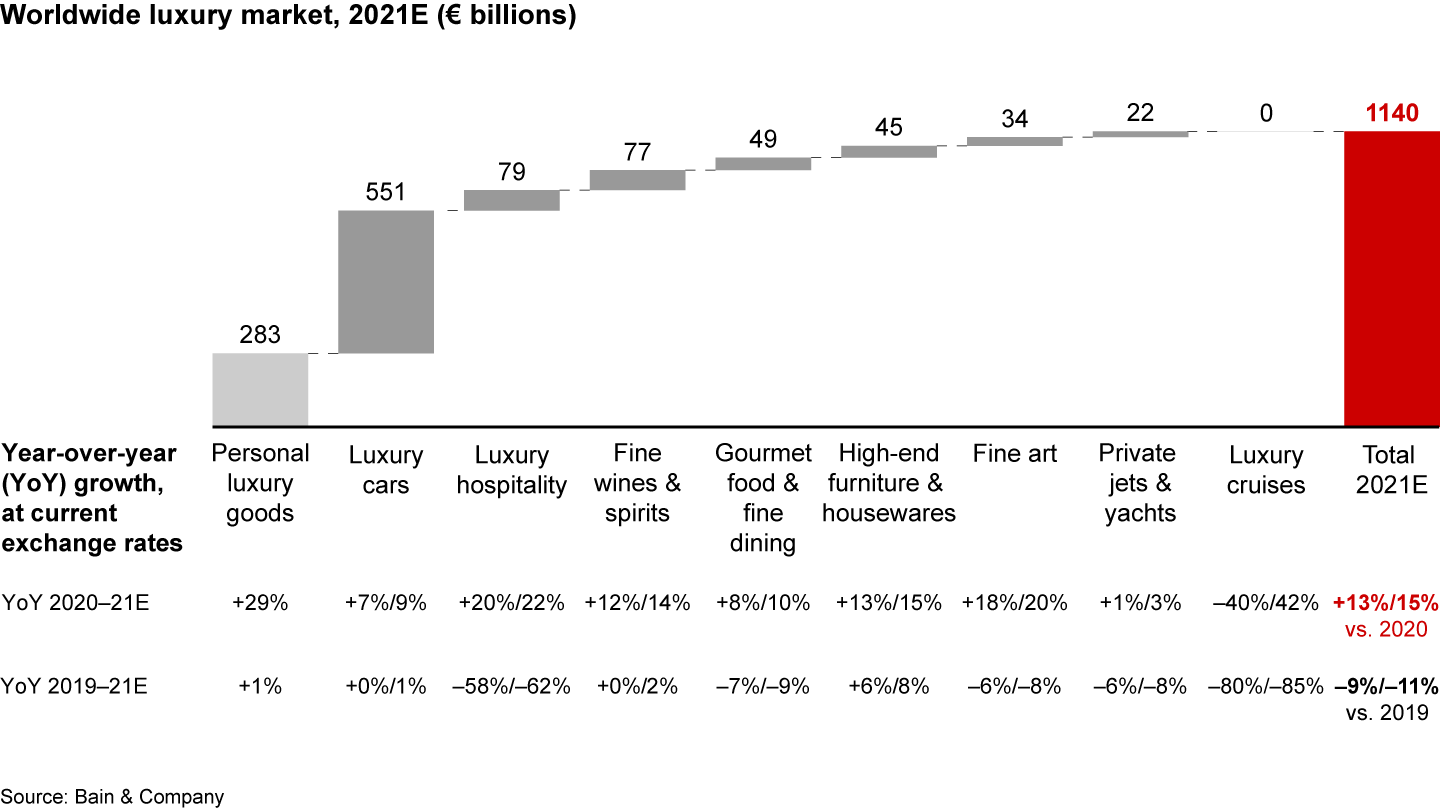

Figures 1-4: Figure 2
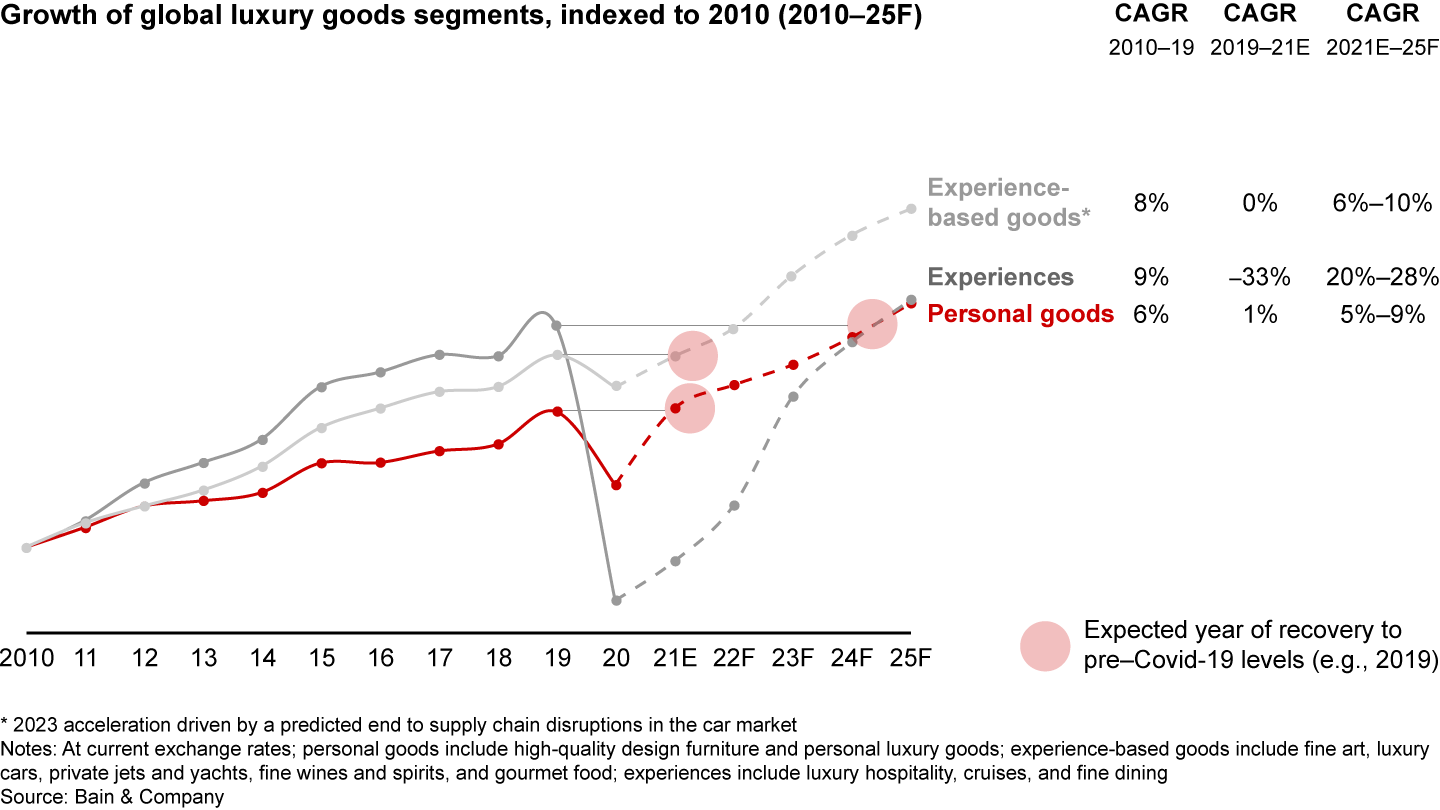

Figures 1-4: Figure 3


Figures 1-4: Figure 4
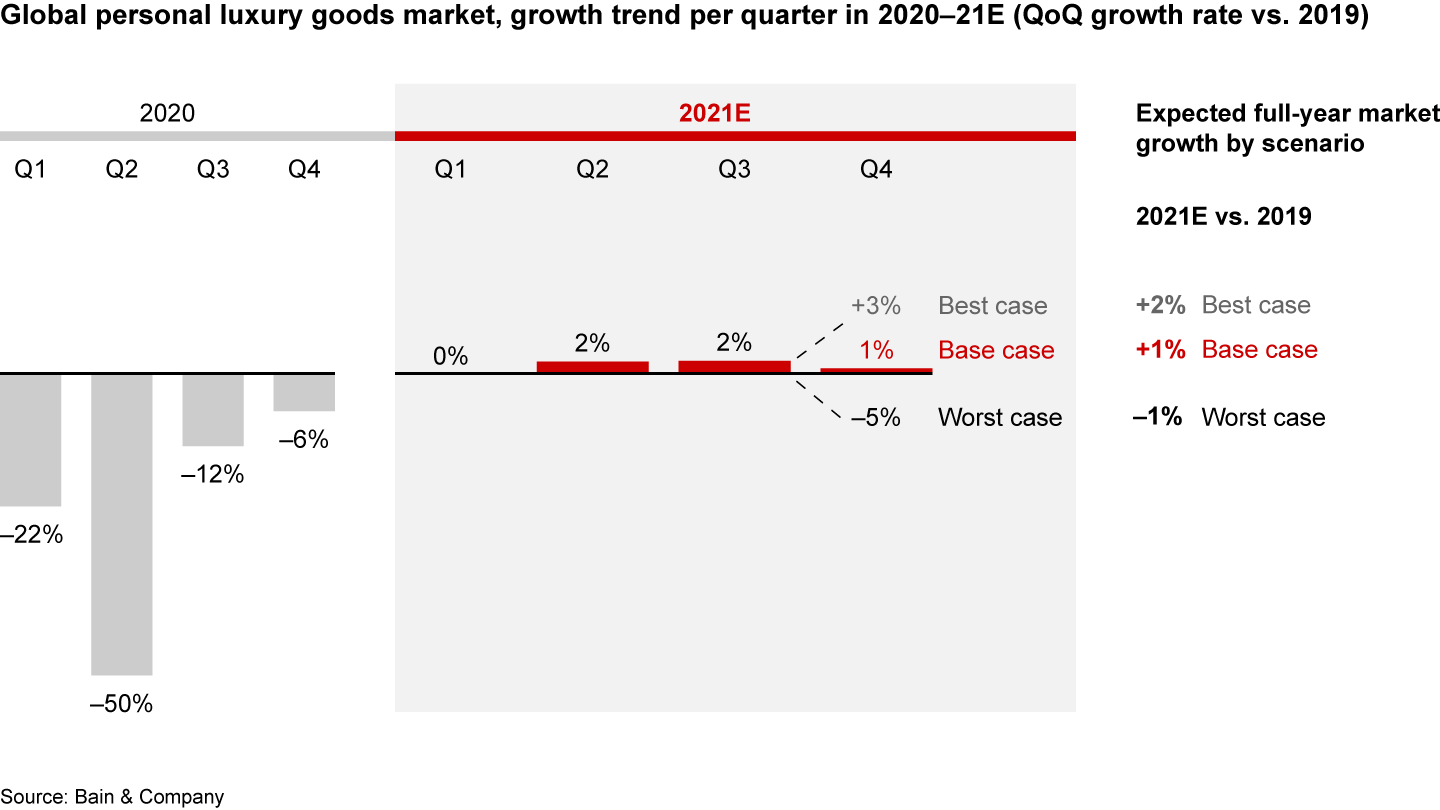


2. Regional highlights
- The global ranking of luxury sales by region remained stable in 2021. Asia, which became top ranked in 2020, retained its eminence, followed by the Americas and Europe.
- The pandemic has nonetheless changed the global map of luxury. As tourism collapsed by 80% to 90%, spending on personal luxury goods by consumers in their home markets picked up the slack, rising by 50% to 60% between 2019 and 2021, according to our forecasts.
- Luxury went local most dramatically in mainland China, whose market is forecast to grow by 36% at current exchange rates to €60 billion; China’s share of the global market has almost doubled in two years, to a forecast 21% in 2021. We anticipate that the corresponding dip in the overall global spending by Chinese consumers will be reversed in the second half of 2022 or the first half of 2023 as tourist flows normalize.
- There was a solid rebound in overall global spending by US and Latin American consumers in 2021, with some previously unheralded cities such as Denver and Austin emerging as luxury hotspots. The Americas account for 31% of the global market (€89 billion), with the US remaining the single biggest national luxury market.
- Local consumption was also strong in Europe, including heavy spending by Russians in Russia. The Middle East was another bright spot, with Dubai and Saudi Arabia leading the growth.
- Japan is forecast to grow by 10% at current exchange rates to €20 billion, still below its 2019 performance. Local consumption was held back by slow vaccine uptake.
- The rest of Asia is expected to return to growth, rising by 19% at current exchange rates to reach €32 billion. The performance of Hong Kong remained weak, while Taiwan and Macau faced more mixed results. South Korea regained its 2019 levels due to the repatriation of local customers’ spending, which more than compensated for the lack of tourism. Southeast Asia, meanwhile, continued to suffer from the dearth of tourists.
Figures 5-8: Figure 5


Figures 5-8: Figure 6
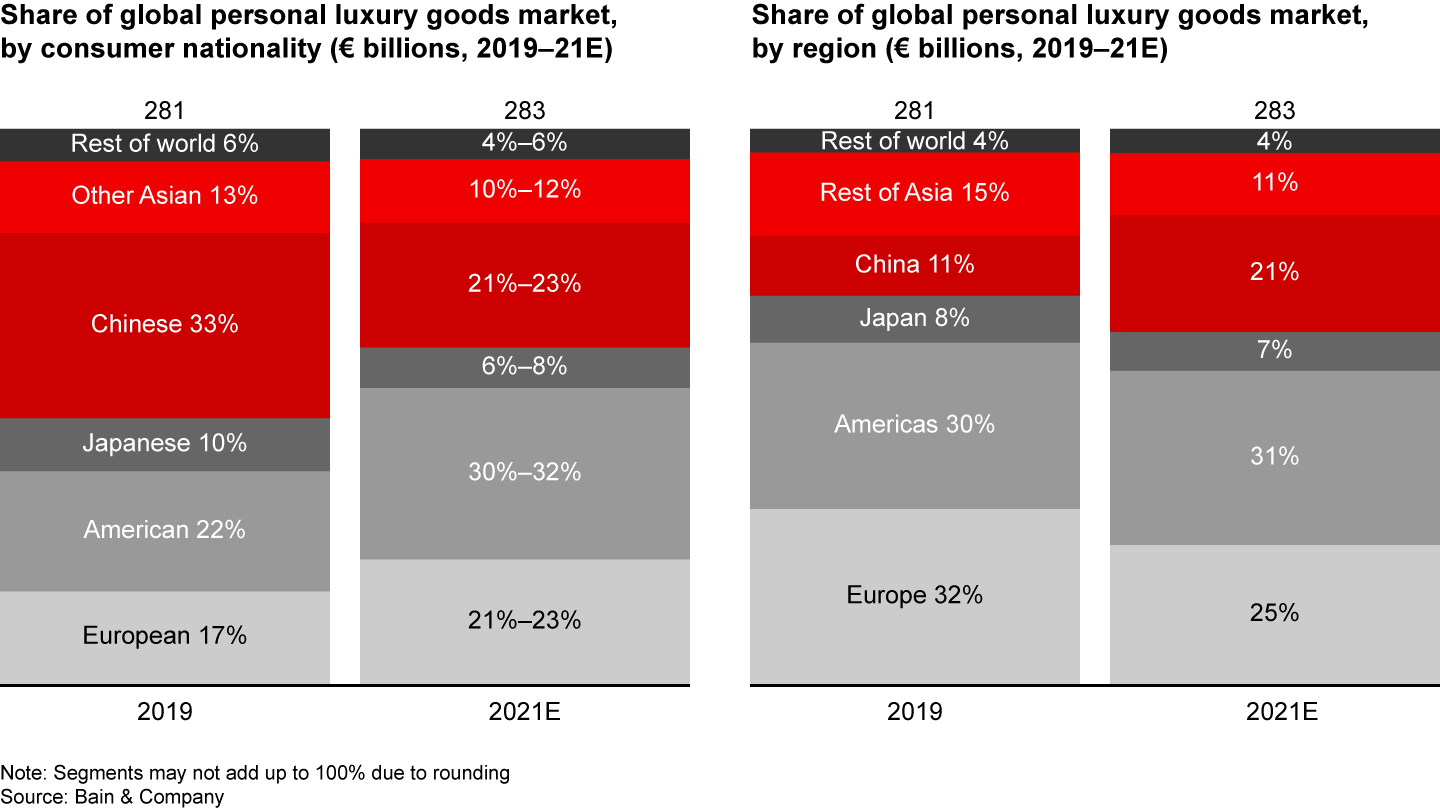

Figures 5-8: Figure 7


Figures 5-8: Figure 8



3. Distribution trends
- Brands continued to increase control over their distribution, with a rise of directly operated channels. The retail channel has grown to the point that it now accounts for almost half the market (a forecast 49% in 2021) and is poised to overtake the wholesale channel, whose share is likely to fall from 54% in 2020 to 51% in 2021.
- Online and monobrand stores were the key channels for 2021’s recovery. After a 50% jump from 2019 to 2020, online continued to power on, growing by 27% from 2020 to 2021 to reach an estimated €62 billion in market value this year, thanks to accelerated adoption during the pandemic. Websites devoted to a single brand are now likely to make up 40% of the online segment, up from 30% in 2019.
- Outlets started to recover thanks to the easing of Covid-19 restrictions but still lagged their historical levels. Department and specialty stores regained local footfall yet remained well behind 2019.
- Bain estimates that the secondhand luxury market soared to reach €33 billion in 2021, driven by increased demand and a growing offer. Overall, the secondhand luxury market grew by 65% between 2017 and 2021, vs. 12% growth for firsthand items.
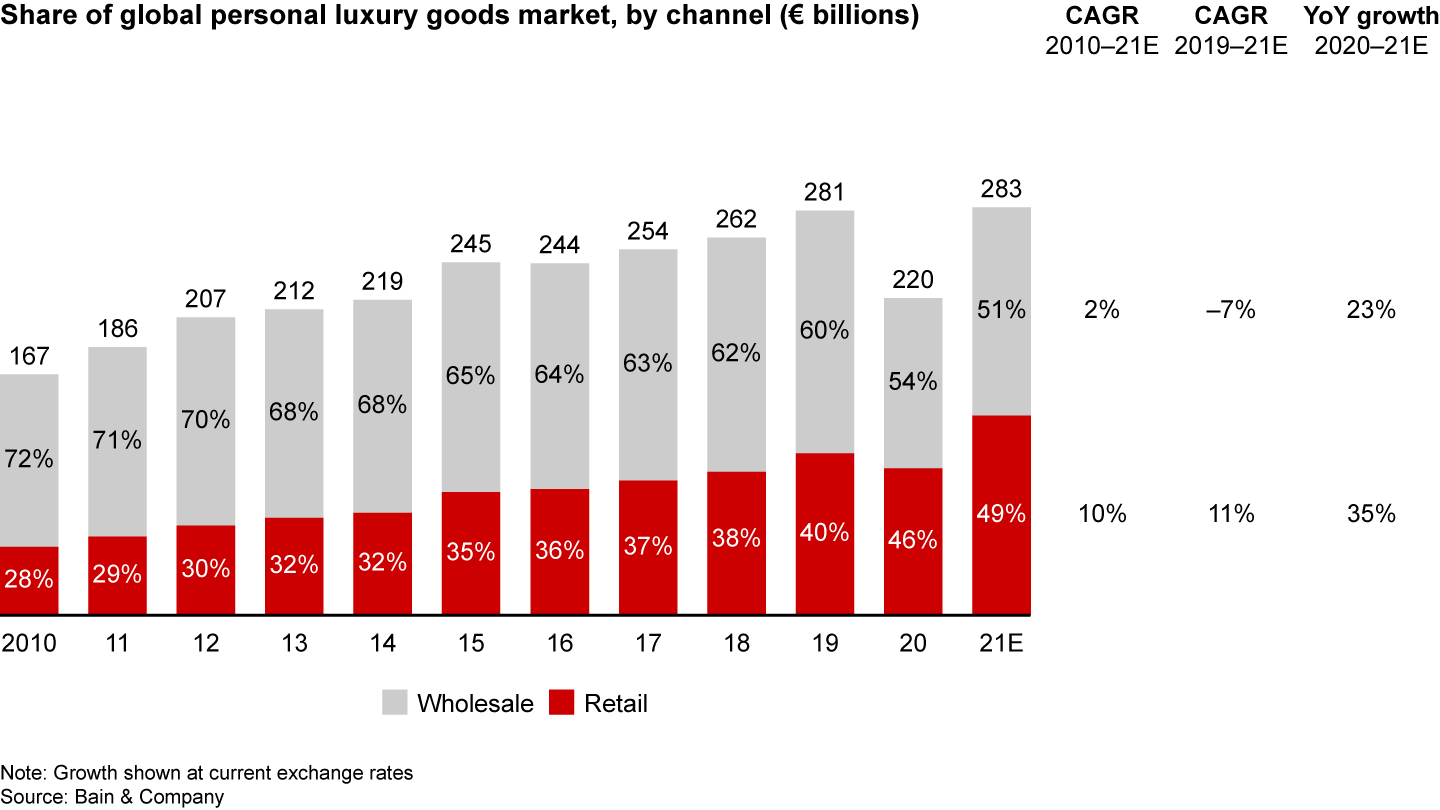

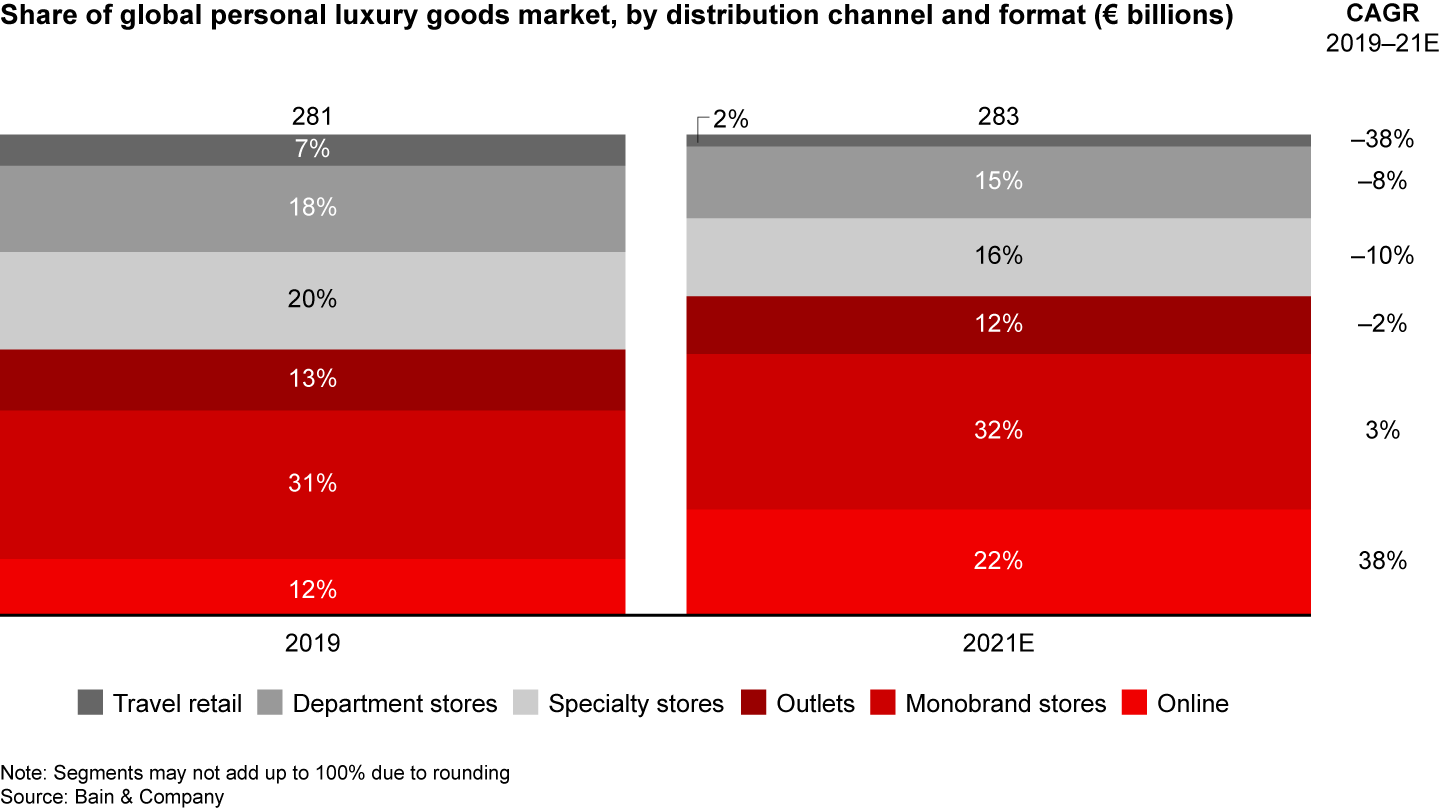

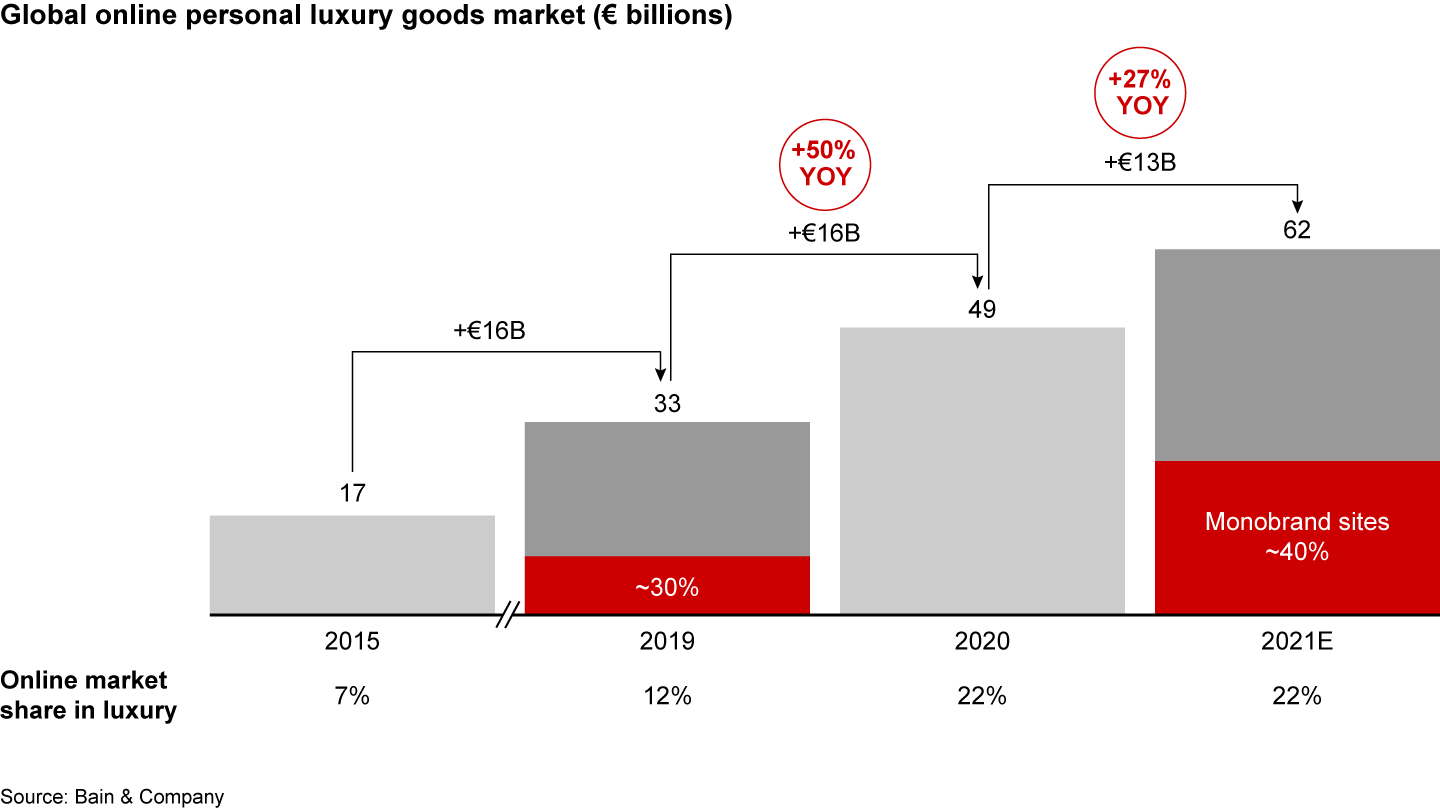




4. Individual category performance
- Shoes, accessories, and jewelry were the product categories that advanced most during the pandemic. They should all surpass their 2019 levels this year.
- According to our forecasts, shoes grew by 11%, compared with 2019, to reach €23 billion amid a continued switch from formal shoes to sneakers, boots, and other casual footwear, especially for men. Women’s occasion shoes also accelerated.
- Accessories remained the largest personal luxury goods category in 2021 and grew by 8% relative to 2019, to reach €62 billion, with iconic product ranges and new must-haves showing strong momentum. Logos were back in favor, primarily in connection with brand heritage.
- Jewelry reached €22 billion, up 7% from 2019, as the appeal of branded luxury jewelry continued to grow in traditionally noncore markets. Unisex jewels became popular, and the online channel played a key role for entry-level-priced goods and custom pieces.
- Watches and beauty grew back to their 2019 levels. The luxury watch market regained its record €40 billion valuation, reflecting solid demand for “über-luxury” and iconic pieces, as well as genderless watches. Beauty recovered to €60 billion, just 1% below its 2019 level. Skin care was boosted by a persistent self-indulgence trend, while demand for makeup and fragrances remained constrained. The weak performance of travel retail is still affecting the entire category.
- The apparel category grew in 2021, but not sufficiently to close the gap with 2019. Womenswear grew faster than menswear, in large part due to the recent acceleration of occasionwear. Comfortwear is now normalized, but formalwear has not recovered. As in accessories, logos are back in fashion.
- Across product categories, traditional price-led segmentation models have lost relevance. Most brands are now covering multiple price points to respond to different customer segments and needs.
Figures 13-14: Figure 13
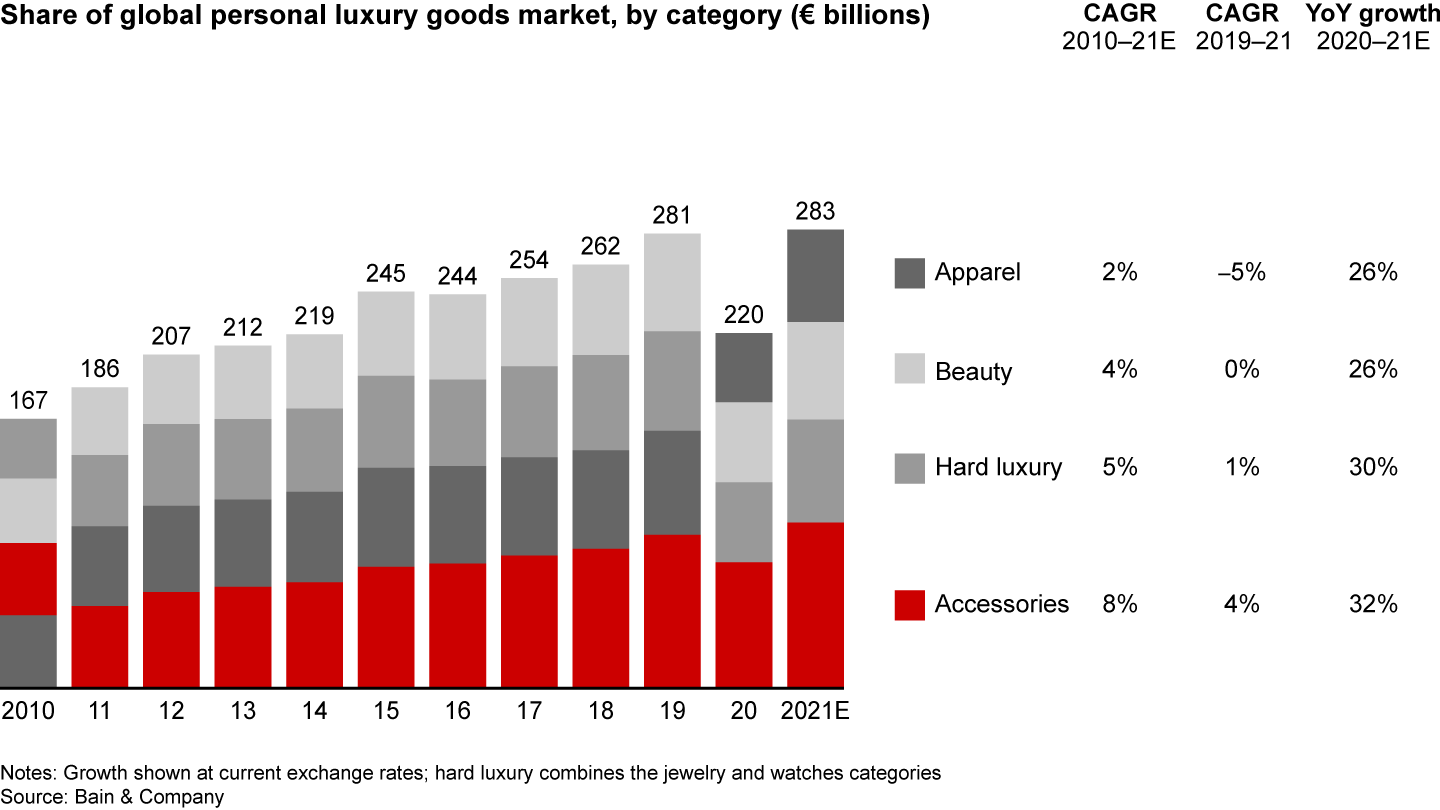

Figures 13-14: Figure 14
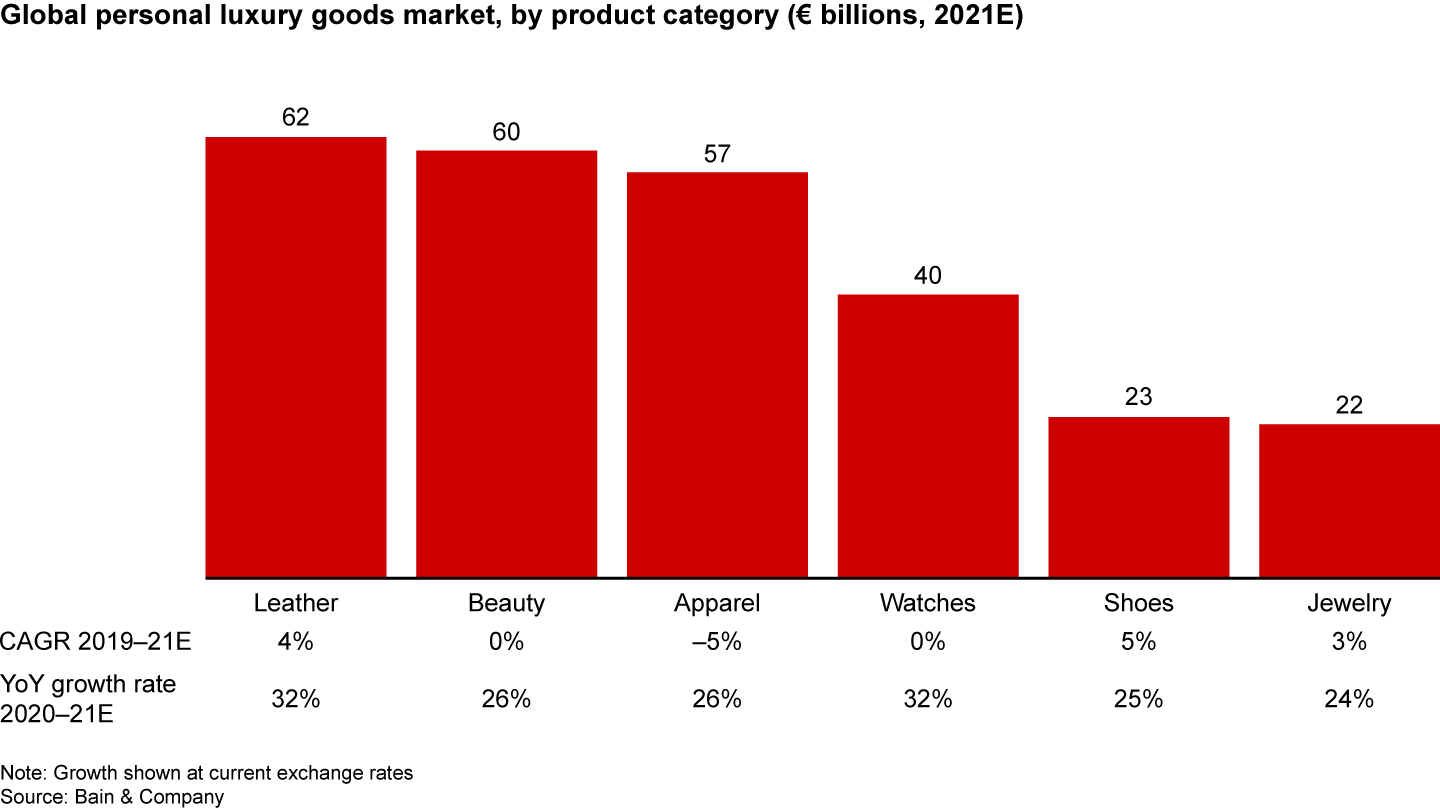


5. Outlook for the future
- Over the last 20 years, leading brands have grown both their share of the market (now reaching close to 33%, vs. 17% in 2000) and scale advantage over other players; they are now up to 18 times bigger than the average brand, compared with only seven times 20 years ago.
- That said, there is still a place for “rising stars” in the industry. These small brands (less than €200 million in retail sales value) make up 2% of the market but are growing twice as fast as the broader industry by appealing to fast-moving consumer trends.
- Luxury brands have faced two years of tremendous turbulence, but the industry comes out of the crisis with more strength, resilience, and agility than before. Profitability has already recovered to pre-Covid levels: We forecast that a typical brand’s earnings before interest and taxes margin nearly doubled in 2021 to 21%, up from 12% in 2020. This turbocharged recovery was enabled by profit-hunting programs rapidly launched during the crisis and by a sales rebound that favored higher-margin direct channels.
- The prompt 2021 rebound suggests that growth will be healthy for the personal luxury goods market in the medium term. We expect the sales recovery to continue over the next four years, with the personal luxury goods market reverting to annual growth rates between 6% and 8% until 2025.
- As we move ahead, we anticipate that four growth trends will profoundly reshape the luxury market by 2025. First, Chinese consumers are set to become the dominant nationality for luxury, growing to represent between 40% to 45% of global purchases. Second, mainland China is on a path to overcome the Americas and Europe to become the biggest luxury market globally. Third, online is set to become the leading channel for luxury purchases. Fourth, younger cohorts (Generations Y and Z) should become more demographically dominant in luxury, representing 70% of global purchases.
Figures 15-18: Figure 15


Figures 15-18: Figure 16
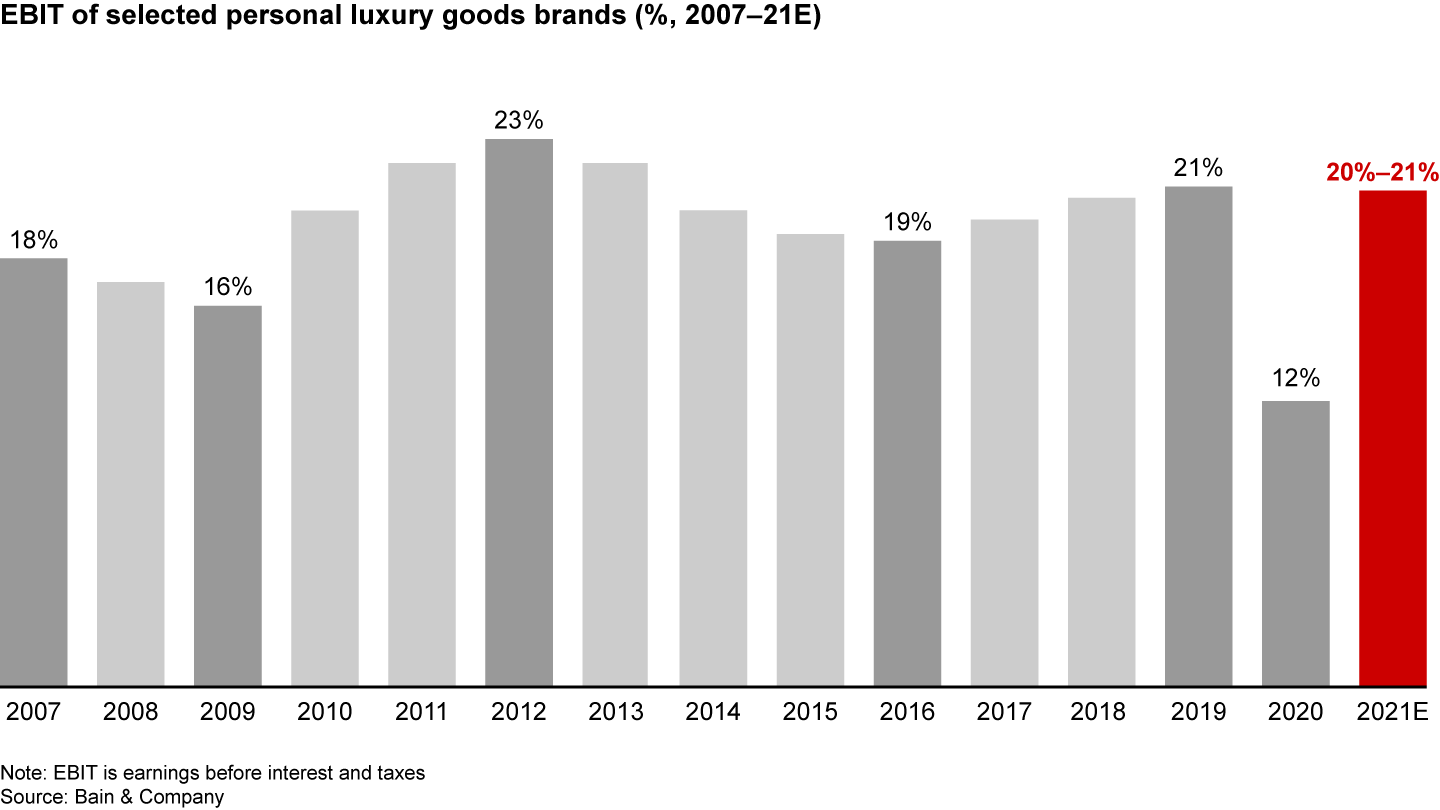

Figures 15-18: Figure 17
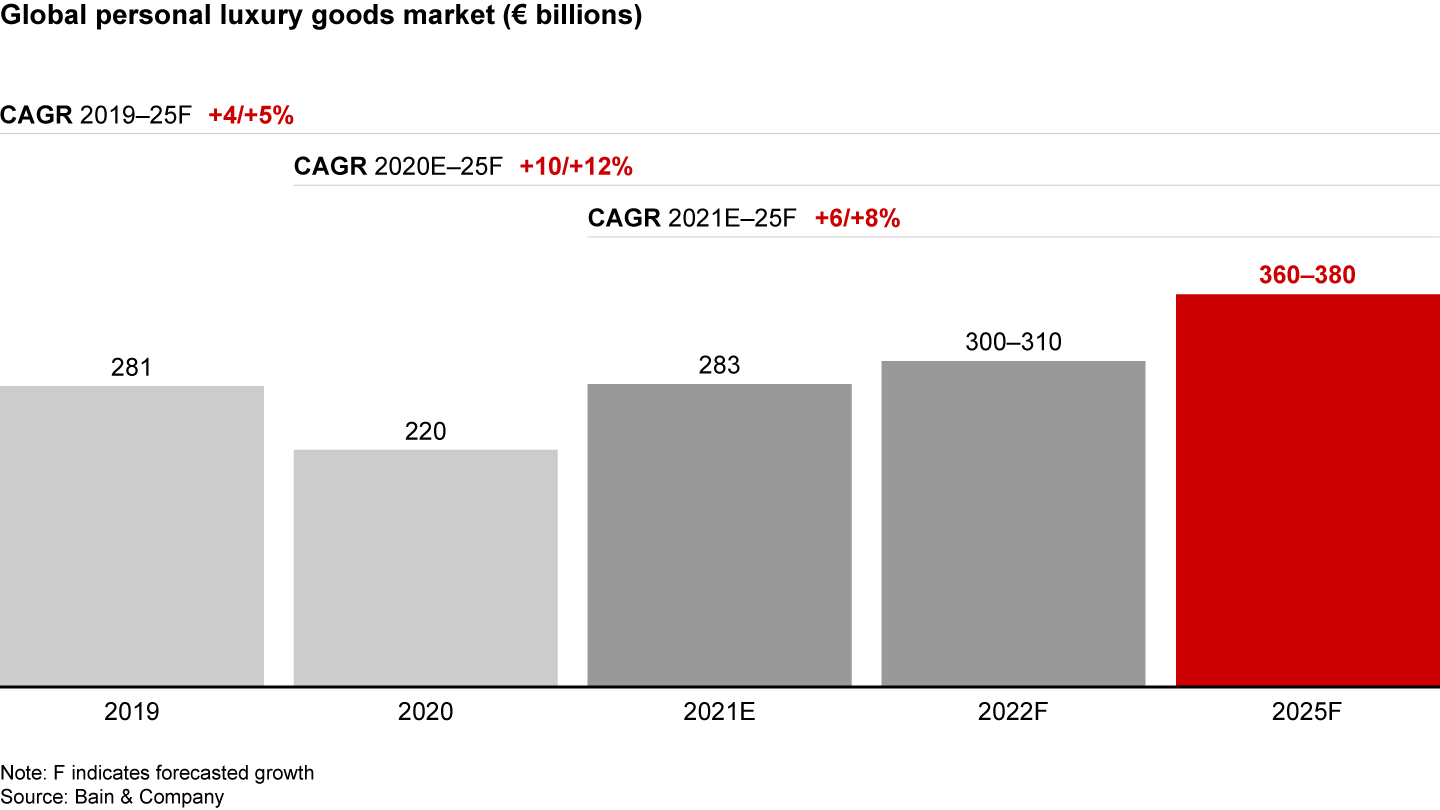

Figures 15-18: Figure 18a


Figures 15-18: Figure 18b
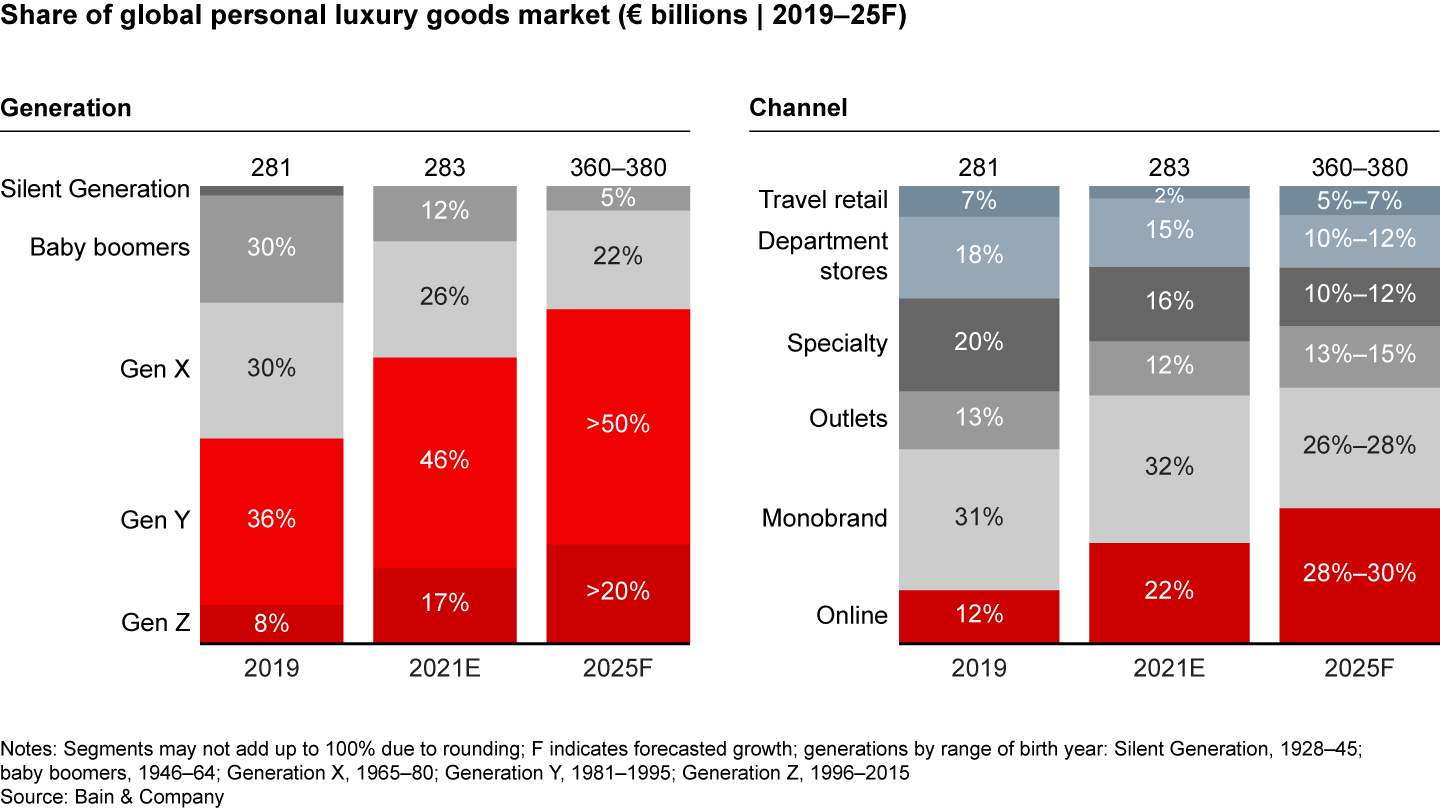

About the Bain Luxury Goods Worldwide Market Study
Bain & Company analyzes for Fondazione Altagamma the market and financial performance of more than 280 leading luxury goods companies and brands. This database, known as the Luxury Goods Worldwide Market Observatory, has become a leading and much-studied source in the international luxury goods industry. Bain has published its annual findings in the Luxury Goods Worldwide Market Study since 2000. The study’s lead author is Claudia D’Arpizio, a Bain partner in Milan. Fondazione Altagamma is led by Matteo Lunelli, who was named chairman in 2020.
Figures 15-18: Figure 19
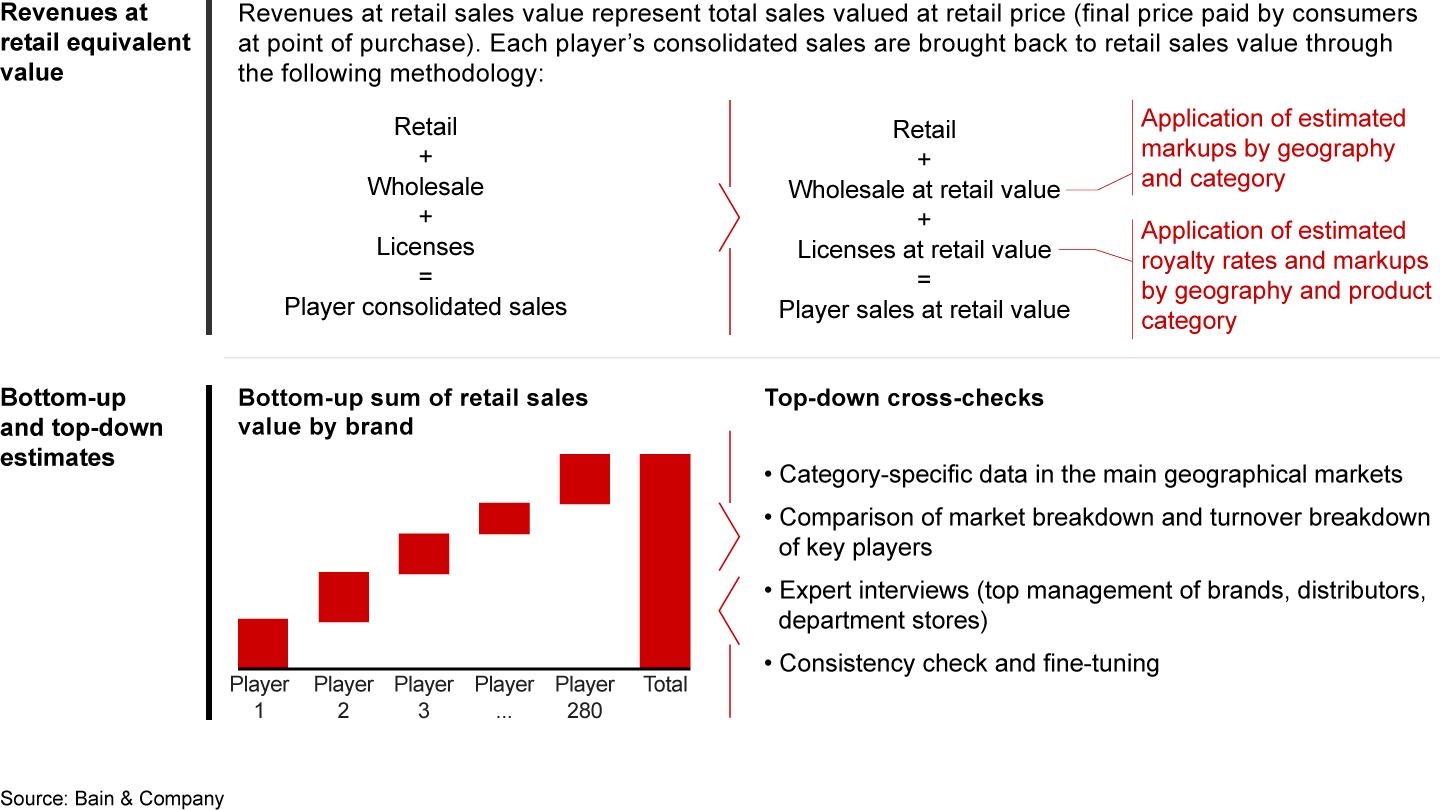

Bain’s insights are based on triangulating information and sources available as of November 5, 2021, including the following:
- Data regarding the outbreak of Covid-19 and consequential lockdowns across countries
- Macroeconomic data (e.g., GDP, consumer confidence index) and latest forecasts
- Current trading performance from relevant luxury industry players
- Annual reports, quarterly results, and analyst reports
- Consensus of 100-plus expert interviews
The scenarios do not consider disruptive changes in Covid-19 status quo (e.g., potential future waves of Covid-19 related to variations of the virus).